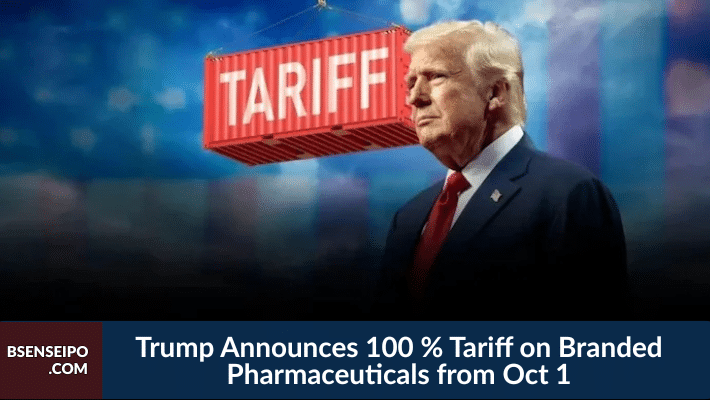Trump Imposes 100 % Tariff on Pharmaceutical Imports — What It Means for Pharma & Markets
Washington, D.C. — September 25, 2025 — In a bold and sweeping move, President Donald Trump announced 100 % tariff on imported branded or patented pharmaceutical products starting October 1, 2025. The tariff, which doubles the cost of affected imports, aims to push pharmaceutical companies to shift or expand manufacturing operations inside the U.S. unless they have already “broken ground” or are “under construction” on domestic facilities.
According to Trump’s statements on Truth Social, the tariff will not apply to pharmaceutical products from firms that are actively building U.S. manufacturing capacity. The move comes as part of an expanded package of import tariffs, which also targets heavy trucks, furniture, kitchen cabinets, and building-related goods.
Trump Announces 100 % Tariff : Why This Move?
The rationale behind the tariff, according to the administration, is to reduce reliance on foreign drug imports, bolster domestic manufacturing, address perceived national security risks, and narrow the U.S. trade deficit.
Critics argue that such a tariff could sharply increase drug prices in the U.S., strain supply chains, and trigger significant backlash from patients, insurers, and pharmaceutical firms. Some also question the legal authority under which the administration can impose such sweeping tariffs.
Impact on Pharmaceutical Products & Global Supply Chains
1. Price Shock & Inflation
- Doubling the cost of imported branded drugs will likely force immediate price increases for many medications in the U.S. market, which could push up healthcare inflation.
- Insurers, Medicare/Medicaid, and private payers may resist or negotiate harder, leading to market friction and possible shortages.
2. Supply Disruptions & Logistical Strain
- Many pharmaceutical companies rely on global supply chains for active pharmaceutical ingredients (APIs), intermediate formulations, or finished formulations. A sudden duty shock may cause supply disruptions or rationing.
- Firms that do not yet have U.S. manufacturing might scramble to redirect production or reconfigure supply lines.
3. Reshoring & Capital Investment
- The tariff incentive for building U.S. plants could accelerate reshoring of drug production. Firms may accelerate planned investments in U.S. manufacturing capacity to qualify for tariff exemption.
- Smaller firms or generic manufacturers may struggle more to mobilize capital quickly.
4. Strategic Re-routing: Generics, Biosimilars, Non-Branded Drugs
- The stated tariff is specific to “branded or patented” pharmaceutical products. Generic, off-patent, or unbranded drugs might be less affected (depending on definitions).
- Companies may escalate development or import of generics to offset branded drug impacts.
5. Regulatory / Legal Challenges
- The legal basis for such tariff imposition — especially against pharmaceuticals — may face court challenges by firms or trade groups.
- Regulatory agencies (FDA, WTO, trade bodies) might push back or seek injunctions.
Impact on Company Stocks & Pharmaceutical Industry Players
The reaction in equity markets, particularly among pharmaceutical firms, could be substantial. Firms with heavy exposure to exports into the U.S. or reliance on imported formulation / finished dosage may suffer. Here’s a breakdown of likely effects:
| Category / Type | Likely Reaction | Examples / Names to Watch |
|---|---|---|
| Large Global Pharma / Brand Players | Negative pressure on margins and revenues for those having significant U.S. import exposure; potential premium discounting | Pfizer, Merck, Roche, Novartis, Johnson & Johnson |
| Companies with U.S. Manufacturing / Existing U.S. Base | Less impacted or better insulated; may see valuation boost as “future-proof” | Companies with U.S. plants or capacity in place |
| Generics / API / Off-Patent Manufacturers | Could gain relative strength if they avoid tariff or reorient supply chains | Indian / Chinese generic players, API suppliers |
| Biotech / Specialty Pharma | High risk if they import finished biologics; may attempt quick investment in U.S. capacity | Biotech firms reliant on cross-border imports |
In markets such as Indian pharmaceutical stocks, reactions may be pronounced because India is a key global supplier of generics and specialty drugs. For instance:
- Indian companies exporting branded drugs or finished formulations to U.S. may suffer margin compression and demand loss.
- Firms focusing more on generics / bulk APIs might see relative resilience or upside as demand shifts.
- The investor community may re-rate valuations downward for high exposure names, while favoring names with less dependency on U.S. exports.
Beyond individual companies, sector indices or pharma ETFs may underperform in U.S. markets or see increased volatility globally.
Risks, Caveats & Uncertainties
- Tariff Enforcement & Legal Validity: It’s not clear which legal authority the administration will invoke, and this may be contested in U.S. courts. Some tariffs previously imposed by Trump (e.g. on steel/aluminum) faced legal scrutiny.
- Exemption Scope & Definitions: How “branded or patented” is defined, and what qualifies as “building a U.S. plant,” may create loopholes or ambiguous interpretations.
- Retaliation / Trade Wars: Countries affected may retaliate or challenge the tariff at the WTO.
- Medical Backlash & Political Pressure: The healthcare sector, patients and insurers may push political backlash, especially if drug affordability suffers.
- Timing & Implementation: The tariff is scheduled to begin October 1 — some companies may rush to pre-empt import or restructure supply chains before then.
Strategic Takeaways for Stakeholders
- Pharma Companies: Must quickly evaluate how much of their revenue / imports are subject to this tariff, accelerate U.S. manufacturing projects, renegotiate supply arrangements, and hedge short-term price risk.
- Investors / Equity Analysts: Reassess valuations of pharma names, downgrade those heavily exposed to U.S. import risks, and potentially scout for emerging winners in generics / API space.
- Governments & Trade Bodies: Expect intense lobbying, negotiation, and potential retaliatory measures.
- Healthcare / Payers / Patients: Increased costs may be passed down to payers or patients unless absorbed; pressure on drug access and coverage.




